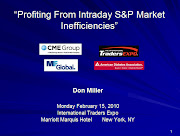 5:50pm Years ago, I attended a Driver's Ed course that included a training simulation where you were driving through a parking lot and everything was thrown at you. First, a car backs out in front of you. Then a loose baby carriage. Then the baby's mother running after the carriage.
5:50pm Years ago, I attended a Driver's Ed course that included a training simulation where you were driving through a parking lot and everything was thrown at you. First, a car backs out in front of you. Then a loose baby carriage. Then the baby's mother running after the carriage.Today felt a lot like that. First, as many were likely positioning long pre-open on the gap down toward Wednesday's supports (I sure was), Microsoft comes out with poor earnings. Then at open the market teases us with holding supports and climbing, before it fails and trends down. Then the market breaks midday consolidation and looks as if it will trend strong into the close -- even holding its first pullback -- before doing a Wile E. Coyote cliff dive
 Trading can be a funny business. Yesterday, I was ticked that I didn't maximize what I felt was available potential. Today on the other hand, I came close to squeezing everything I could out of a roller coaster day where change was the word of the day, and as a result colored much of the performance grid to the left at least bright green. I was especially satisfied with how I reacted to the continual change in market conditions.
Trading can be a funny business. Yesterday, I was ticked that I didn't maximize what I felt was available potential. Today on the other hand, I came close to squeezing everything I could out of a roller coaster day where change was the word of the day, and as a result colored much of the performance grid to the left at least bright green. I was especially satisfied with how I reacted to the continual change in market conditions.As is sometimes the case, most of my prime sequences today were 1st pullback types, where I entered on the first pullback and took the trade off as the market made its first thrust. The afternoon was a good example where I nailed both the 5- and 10-minute pullbacks (see attached charts; click to enlarge), and took the high-probability scalp into the next push of retail buying before retreating to cash. And in both cases, that's all the market gave as the S&Ps traded completely within yesterday's range.
On strong trend days, such a strategy looks foolish (although if the market does run, there's usually a high % contra-trend trade or 1st pullback on the next larger timeframe). On days like today, it looks incredibly smart.
It's really neither.
It's simply trading.
Poker night tonight ... I'll check comments later tonight.
















10 comments:
Don, I am curious if you still employ the 3 and 13 minute charts. You referenced the 5 and 10 min today, so just checking to see if you still like that methodology.
The market seems to like trapping pullback buyers and middle traders these days, messing with both sides.
I find my best trades are at the ends, where I can use tighter stops,especially if I get the trade sequence correct.
Pulling the trigger on a gap resistance momo trade takes courage, but with profits in hand, risk reward changes and I reasoned yesterday's high was stop via the 60 min grail.
Hindsight is always easy, the trick is to see it and react in real time.
E.
Hey Don,
Thanks for keeping the blog going. I've wanted to ask you this before, and since you touch a bit on again today, I wonder if you could comment in a bit more detail on how you decide when to scale out of profitable positions. You mention scaling out with the first thrust--is that just a feel thing, or do you use ticks or price targets or other data to help with that?
Thanks,
BLE
Hi E.
I know I've used 3 & 13 in the past, primarily because the 3 min 15MA and the 13 min 15MA equate to the 1 min 50 and 200 supports which many traders watch.
Yet, they're all so darn close (3 vs. 5; 13 vs. 15 or 20) that it really doesn't matter in the scheme of things. 5 & 15 stretch out the timeframes a bit, but the difference is immaterial.
Yea, the market as usual seems to be trying its best to frustrate everyone ... yet I suppose so long as we trade with an open mind, the potential remains.
It's interesting that while my tight January play has been driving me crazy, it actually may have saved me on a day like today where you had to be extremely tight all around.
Don
Hey BLE,
That's a darn good question and I wish I had a solid answer. I also honestly think I'll be working on my exits until the day I die.
Suffice it to say that I'm usually pretty tight with my trading and exits ... and some may argue overly tight (which I actually might agree with this month).
It really depends on the type of sequence. For example, I'm often taking frequent contra-trend scalps on retail price over-extensions, and if so I'm only looking for a few TICKS and may dump all of it at once. If I'm trading with the trend, I'll more often look to scale out.
In terms of suppport based trend trades, I don't use price targets and usually always take something out of the trade as it begins moving in my direction and I often use TICK pushes back toward +1000 or -1000 to help gauge.
The exception is when I actually add to a position when the trade begins moving in my direction so long as I believe there's adequate price movement potential. Of course I rarely do that unless there's a high probability of a sharp continued move, which was the case last fall when the market was going crazy and we were literally being handed 10 point "scalps" at times.
I do always scale out though, often in 1/3s. Today for example, I think I traded lot sizes ranging from 15 to 75 contracts, and I'd scale out of the 15s 5 at a time and the 75s 25 at a time. Sometimes, if I'm heavy I'll break the last lot into even smaller pieces as I may have done when I did some of the live blog trade narrations last year.
Yet as I've stated throughout the blog, I don't advocate a particular method ... I simply do what's comfortable and proven for me.
I suppose the "tight" play might explain why my daily win/loss has historically been so high, although it does limit the home run days.
But I'll probably always be a singles and doubles hitter. Plus, I don't like to gamble and prefer to pursue the high probability results.
Hope that helps.
Don
Hi, Don,
I heard today an interview you had recently on TraderInterviews and was very impressed. I also find your blog very educational. I don't trade futures, but your philosophy and strategies are equally instructive.
You said something to the effect that you use multiple time frames to feel the rhythm of the market. Could you please elaborate on that?
Don, I'm currently an intraday independent trader in Chicago. I recently started doing this full time and have had some problems with the emotional side of trading. I think I'm real good at picking up reversals, mkt direction and psychology, but I tend to panic and close positions too early. Would you be willing to meet for coffee one day? I think I could learn a lot from you in just a few minutes of chatter.
Tony
Hi Tony -
That would be tough since I don't trade in Chicago [I trade electronically in the Northeast.]
For now, I'm using the blog diary to share my thoughts which is probably the best way for interested onlookers to get inside my head as I constantly babble to myself.
We did some live PalTalk lounge discussions a few months ago (an online chat/video forum) -- and I might resurrect that in the future if there's interest as blog hits for some reason have surged yet again recently -- although the intent wouldn't be to teach or recommend certain strategies as noted in the FAQ.
I do believe trading is predominatly mental though. I know when I struggle, it's almost always psychological, and I've had my share of pain related to losses, missed opportunities, etc.
And while I don't recommend specific vendors, Brett Steenbarger has some great stuff in his first book "The Psychology of Trading" which might help. In it, he specifically talks about mentally separating the entry trader from the exit trader. It's the best book I've ever read on market psychology.
Don
Hi Charlie -
I simply mentally view the market in terms of what it's doing on various timeframes.
For example, it may be consolidating and looking like a chopfest on an hourly chart, while there are clear 5-minute trends.
Or it may be in an hourly downtrend, where once the lesser timeframe that is trading contra to the hourly (in a pullback) turns, it can be a useful trigger and/or confirmation of a possible trend extension.
It's just a way for me to try to see what market rhythm is currently in force, and looking at trends on 1-min through 60-min helps me visualize and sense the action.
Don
Hi Don,
Just wanted to congratulate you on the brilliant interview with Tim Bourquin-one of the best to date! I found it extremely insightful and love the way you approach trading. Your blog is a gem for someone (like myself) looking to excel in this business. Especially like the little fictious equity curve! I find myself taking similar measures to curb the effects of euphoria in my own trading. Will be bookmarking this site for sure....
Thanks for the kind comments and welcome to the site Market Monkey :-).
Post a Comment